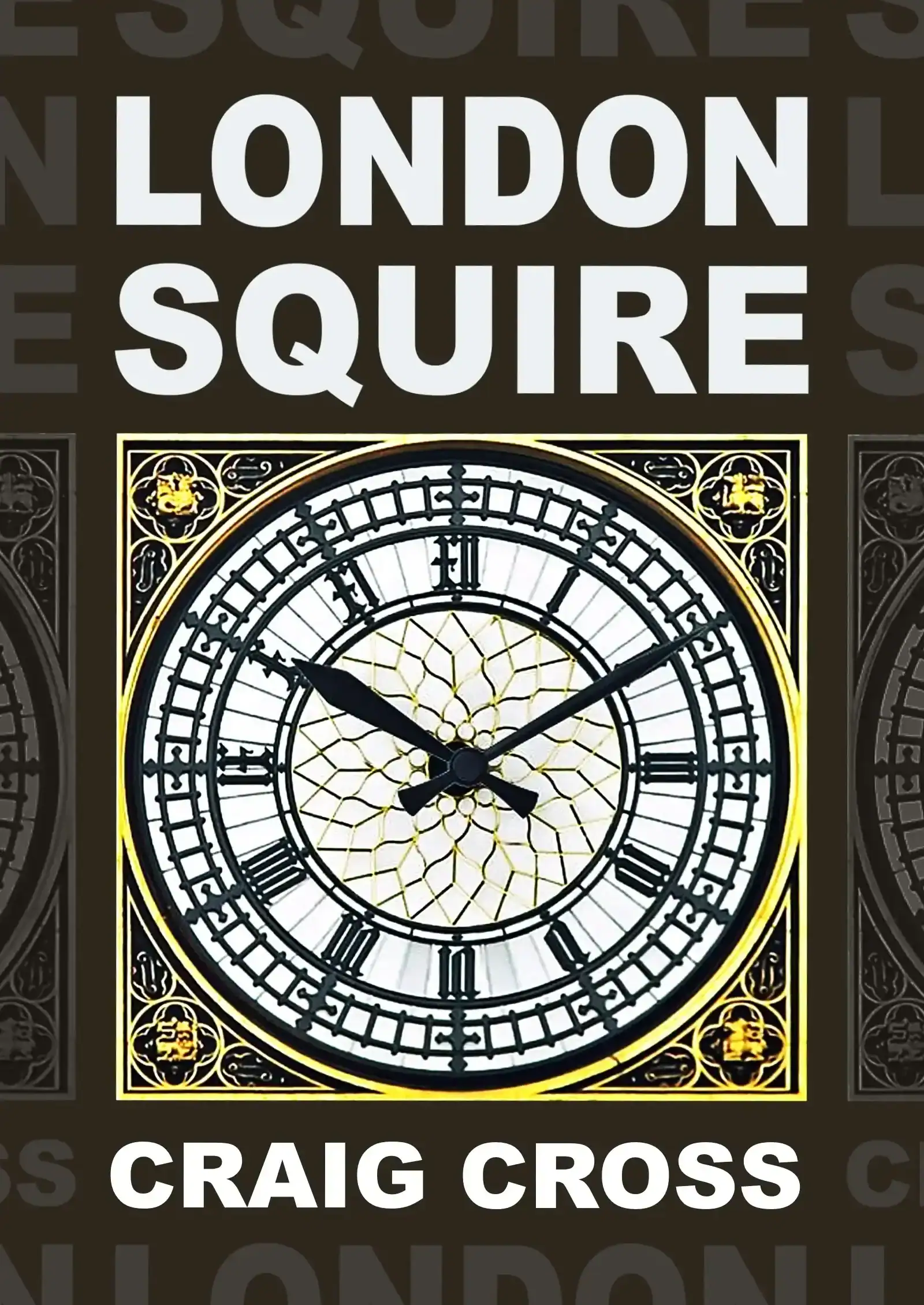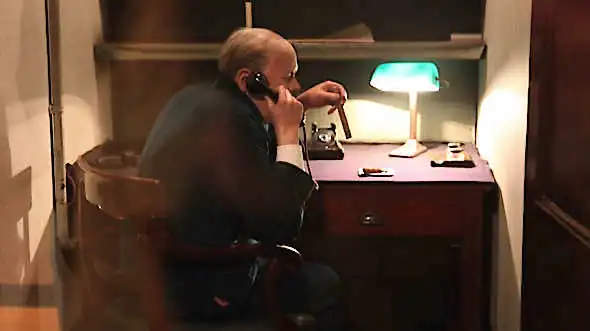You know that war’s inevitable when they start digging bomb shelters for the government. Chamberlain began planning these four months before his ‘Peace In Our Time’ speech, so whilst he was standing on the tarmac waving that piece of paper about in May 1938 he was simultaneously ordering some furious digging and drilling beneath the Treasury – he never told us that, did he! He got the whole thing completed just one week before war broke out, and the first bomb dropped on London four months after that. Sixteen weeks later Churchill was in charge.
The War Rooms aren’t much to look at from the outside, just a door and some descending stairs that go down about fifteen feet. The first time I came here I was expecting a proper bunker not a basement, i.e., something that you reached in a military lift. But in reality it’s just fifteen steps beneath the street. Then you pass the shop and toilets and ticket desk, pick up some headphones, put them on, reset your imagination back to May 1940… and enter the world of wartime London.
You’ll be walking down long corridors with heavy metal girders and arteries of iron pipes and skinny little wires snaking their way between buzzing lightbulbs. They’ve got rifle racks and fire hoses on the walls, old signs swinging on their original hinges, and a couple of waxwork soldiers guarding the restricted areas. It must have been pretty dark and smoky judging by all the ashtrays all over the place. With all the dumb health and safety laws nowadays they’d probably make you stand outside in the street if you wanted a puff, even in the middle of an air-raid.
As you wander around the gloomy corridors you’ll be clutching a chunky audio-guide that looks like a 1980s mobile phone. When you hold it up to your ear it describes each room in detail with dramatisations of the meetings and conversations going on inside. The acting is pretty good. They’ve got a decent Churchill and a succession of plummy voiced generals and Air Force attaches. Every now and then their conversations will be punctured by the shrill whistle of an incoming bomb followed by a booming blast, and it’s very easy to imagine the walls shaking and dust flooding the tunnels.
War Cabinet Room & Transatlantic Telephone Room
The first room you see is the most important one: the War Cabinet Room, which still has its original arrangement of tables and chairs. You won’t believe how cramped it is. Winston’s seat is right in the middle and the rest of them are practically on his lap. His desk is decorated with a cheap tin ashtray and half-chewed cigar and everybody else has got a dog-eared paper pad and pencil stub.
Next up is the pokey little Transatlantic Telephone Room where he sat chatting with the American President. It’s no bigger than a broom cupboard really, just a desk and a telephone and a waxwork Churchill puffing on a big cigar.
Winston Churchill Museum
After that you have to make a detour through the Churchill Museum which is easily the best WW2 museum in London (definitely better than the Imperial War Museum). It’s almost like a shrine to Churchill. They’ve got lots of news reels, posters and photos, his black bowler hat and red romper suit – even the little pistol that he would have brandished at the Nazis had they made it past Horse Guards. I enjoyed reading all the diary writings from his staff. They all seemed to find him absolutely infuriating but loved him nonetheless. Even his wife Clemmie seemed to battle with him daily, but I get the impression that he was a big softie when it came to her. He’d argue with her, drive her mad and half an hour later he’d be regretting every single word he’d said.
You get lots of information about the build up to the war and the individual battles, plus a bit about the Enigma machine. After that comes his collection of medals and watercolour paintings. You’ll also learn lots of nice little details like how many cigars he smoked a day – eight, including one straight after breakfast – and his favourite brand of champagne – Pol (but not for breakfast, he had wine for breakfast. Then more booze at lunch, one for dinner and a brandy before bed. You can’t help but admire the guy.)
Churchill’s State Funeral at St. Paul’s Cathedral
I definitely recommend sitting down and watching the movie of his State funeral at St. Paul’s Cathedral. It covers the whole thing from start to finish and has some of the saddest sounds you’ll ever hear, especially the slow, shuffling footsteps up the stairs as they carry his coffin through the door. Then they load him onto a boat and carry him up the Thames, past Tower Bridge and all the stooping cranes, and then a fleet of jets streak across the sky and you’re reminded that he didn’t die until the 1960s. It’s a very moving video, and well worth a watch.
It was at this point that I stopped for a mug of greasy tea in the cafe. It’s worth poking your nose in there just to see all the wartime posters on the wall and listen to the 1940s tunes playing out the radio. It’s all Dame Vera Lynn and We’ll Meet Again, stuff like that, barbershop quartets and the Glenn Miller band.
After that you head back onto the tour and see a series of pokey little bedrooms for the detectives and military advisors. They’re not much bigger than prisons cells really – just a tubular bed and scratchy camp blanket. You can see everything from their chamber pot, toothbrush and mug, to an Ebenezer Scrooge-style candle stub melted onto a saucer.
Chiefs of Staff Conference Room
After that comes the Chiefs of Staff Conference Room… strangely placed next to Clemmie’s bedroom. So you’ve got the heads of the Army, Air Force and Royal Navy discussing battle plans on one side of the wall, and the flowery pink bedspread of Winston’s wife on the other.
Most of the rooms from this point on are staffed by waxworks acting out their jobs: answering phones and tapping out letters on their clapped-out typewriters. You can almost hear the tring tring tring of Bakelite telephones vibrating on the desks. After a few more pokey little rooms you reach the HQ of the Home Forces with their desks covered in folders and files and stacks and racks of letters. There’s a big filing cabinet at the back plus a sand bucket and shovel in case the Germans dropped a bomb on the roof.
The Map Room
Next comes the Map Room with huge charts and graphs punctured with little pins and coloured strings tracing out the military front. There’s a long desk with a spider of wires and ten telephones on it: black and white ones, red and green, they probably had the PM on one line, General Ismay on another. The desk is overflowing with files and folders marked Important! Immediate! and I’m guessing these waxworks never had a tea break, and never slept either, judging by all the ringing and binging phones constantly sounding off on the speakers. In other parts of the bunker you hear sirens, but in here it’s never-ending telephones.
Apparently they left this room exactly as it was at the end of the war – even down to the sugar-lumps on the table. They froze it and closed it and here it is behind a pane of glass… all perfectly preserved like it was still 1945.
Winston Churchill’s bedroom
The final stop is the Prime Minister’s plush bedroom with a chamber pot and candle by the bed (plus his morning cigar, of course), map of the battlefront on the wall, and a big desk and BBC microphone where he recorded some of his most important wartime speeches.
It’s worth mentioning that they have a very good shop at the Churchill War Rooms if you’re into World War II. They have a huge selection of books and posters and postcards for sale.
If you enjoy this then try HMS Belfast (take a tube journey from Westminster to London Bridge) and Imperial War Museum (walk it in 20 mins or travel from Westminster to Lambeth North via tube). Other World War II attractions well-worth visiting are the RAF Museum, which has a great collection of Battle of Britain-era planes, and Bletchley Park, where Alan Turing’s team managed to crack the Enigma codes.
 The author Craig Cross owns city-guide.london and has spent the last decade reviewing the capital’s landmarks, attractions and hotels. His guidebook London Squire is available from Amazon
The author Craig Cross owns city-guide.london and has spent the last decade reviewing the capital’s landmarks, attractions and hotels. His guidebook London Squire is available from Amazon

Your comments and questions
Sue We found out after we exited the tour that the Churchill Museum was inside. We never found it. We must have walked past it without realising. But if you go I advise you to look out for the Museum when you are walking around the corridors, otherwise you may get to the exit like us and miss it completely
John Very atmospheric. I loved seeing Winston Churchill's little bedroom because you can just imagine him sitting in there with the sound of bombs falling outside. If you go then I recommend listening to the earphone commentary, because that adds a lot of the atmosphere with the sounds of what it must have been like to work there. You also learn what each room is for, which you could never have guessed on your own.
Lou Hi. Can we get 2-for-1 entry at the Churchill War Rooms? Does the offer you can get with your train ticket still apply?
Craig Hi Lou. At the time of writing you can still do the 2-for-1, as long as you have a paper National Rail ticket on the day, but you should double-check on their website first because their offers do change from time to time - daysoutguide.co.uk/2for1-london
Becky Hi Craig. I get terribly claustrophobic when I'm underground and I'm worried that I might suffer once I get inside. Is it dark? because that is what affects me the most. Is there anywhere I can visit on my own nearby while my family go inside?
Craig Hi Becky. It's certainly gloomy and low-light, but I wouldn't say it's dark. It's not pitch black. The darkest part is probably the Churchill Museum which is very dark apart from the illuminated tables and display cases, but you can easily skip that section and continue with the tour if you want. You can't actually go inside any of the rooms (apart from the Map Room). You just look at the them through a window in the corridor, and the corridors are just normal sized corridors, so they can become a little bit cramped when everyone is bunching up to look through the windows. If you're claustrophobic then bear in mind that parts of the audioguide have dramatisations of falling bombs and air-raid sirens. There are a few attractions nearby that I recommend. Banqueting House is worth a look for the Rubens on the ceiling, and Westminster Abbey is over the other side of Parliament Square. You could even walk down to Trafalgar Square and visit the National Gallery if you want, because that's only a five-minute walk.
Leave a comment